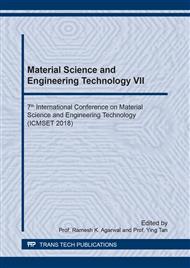p.32
p.38
p.44
p.50
p.55
p.60
p.65
p.70
p.75
Recent Advances on the Deformation Behavior of Two-Phase α+β Titanium Alloys
Abstract:
Two-phase materials, such as α+β Titanium (Ti) alloys, are technologically important. A number of factors can affect deformation behavior, including the interaction stresses between phases, the crystallographic relationships between phases, and the morphology. As a result, the deformation mechanisms of two-phase alloys may be different from the individual single-phase materials. For example, twinning may not occur in a single phase material if the grain size is very small but twinning can occur in a very fine grained alloy if the second phase contributes to the interfacial stresses due to elastic interactions. Interaction stresses can result from the difference in the elastic properties of the two phases. In particular, these elastic interaction stresses can be quantified by the finite element method (FEM). In this paper recent developments regarding two-phase deformation mechanisms will be reviewed and the ramifications on mechanical behavior in regard to two-phase Ti alloys in particular and on two-phase metallic materials in general will be outlined.
Info:
Periodical:
Pages:
55-59
Citation:
Online since:
April 2019
Authors:
Keywords:
Price:
Сopyright:
© 2019 Trans Tech Publications Ltd. All Rights Reserved
Share:
Citation:


